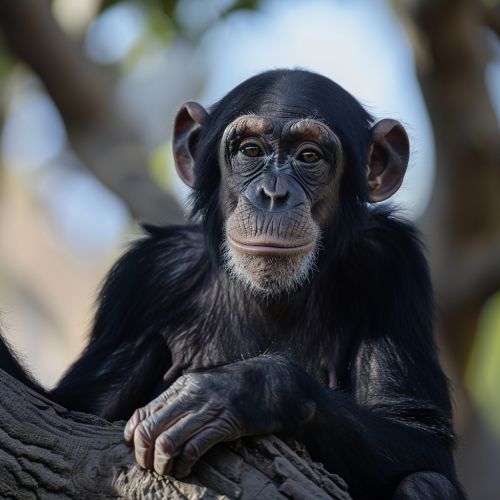Chimpanzees
Taxonomy and Evolution
Chimpanzees, or Pan troglodytes, belong to the family Hominidae, also known as the great apes. They are one of the two species in the genus Pan, the other being the bonobo. The genus Pan is part of the subfamily Homininae, to which humans also belong.
The taxonomic classification of chimpanzees has undergone several revisions since they were first described by Johann Friedrich Blumenbach in 1775. Initially, they were classified as a single species, but later split into two species based on differences in behavior, morphology, and geographic distribution.
Chimpanzees are considered the closest living relatives to humans, sharing approximately 98.7% of our DNA. This close genetic relationship was confirmed through the Chimpanzee Genome Project, which sequenced the complete genome of the chimpanzee and compared it to the human genome.


Physical Characteristics
Chimpanzees are medium-sized apes with a robust build. Adult males typically weigh between 40 and 60 kilograms, while females are slightly smaller, weighing between 32 and 47 kilograms. They have long arms, short legs, and no tail.
Their bodies are covered in coarse black hair, except for the face, fingers, toes, palms of the hands, and soles of the feet. They have a prominent brow ridge and a large braincase. Their faces are pinkish to black, and the skin color can change over their lifetime.
Chimpanzees have a unique set of physical adaptations that allow them to swing from branch to branch in a form of locomotion known as brachiation. These adaptations include long, strong arms, flexible shoulder joints, and a specially adapted wrist joint.
Behavior and Social Structure
Chimpanzees live in complex social groups known as communities or troops, which can consist of up to 150 individuals. These communities are fission-fusion societies, meaning that the size and composition of the group change as individuals move in and out of the group.
Chimpanzees have a male-dominated social hierarchy, with the alpha male at the top. The alpha male is not necessarily the largest or strongest individual, but rather the one who can best form alliances with other males.
Chimpanzees communicate using a variety of vocalizations, gestures, and facial expressions. They also use tools for various purposes, such as extracting termites from their mounds or cracking open nuts. This tool use is considered evidence of their advanced problem-solving abilities.
Diet
Chimpanzees are omnivorous, eating a wide variety of foods. Their diet primarily consists of fruits, but they also eat leaves, bark, honey, insects, and meat. They are known to hunt smaller mammals, such as monkeys and bushbabies, in organized groups.
Their food choices and foraging behaviors are complex and can vary greatly between different communities. This dietary flexibility allows chimpanzees to inhabit a wide range of habitats and adapt to seasonal changes in food availability.
Reproduction and Life Cycle
Female chimpanzees reach sexual maturity between the ages of 11 and 15, while males mature a few years later. Females give birth to a single infant after a gestation period of approximately eight months.
Infants are highly dependent on their mothers for the first few years of life. They start to become more independent at around five years of age, but often remain close to their mothers until they reach adolescence.
The lifespan of a chimpanzee in the wild is typically between 40 and 50 years, although individuals in captivity can live into their 60s.
Conservation Status
Chimpanzees are currently listed as endangered by the International Union for Conservation of Nature (IUCN). Their populations are declining due to habitat loss, hunting, and disease.
Conservation efforts for chimpanzees include habitat protection, anti-poaching measures, and captive breeding programs. However, these efforts are often hindered by a lack of funding and political will.
